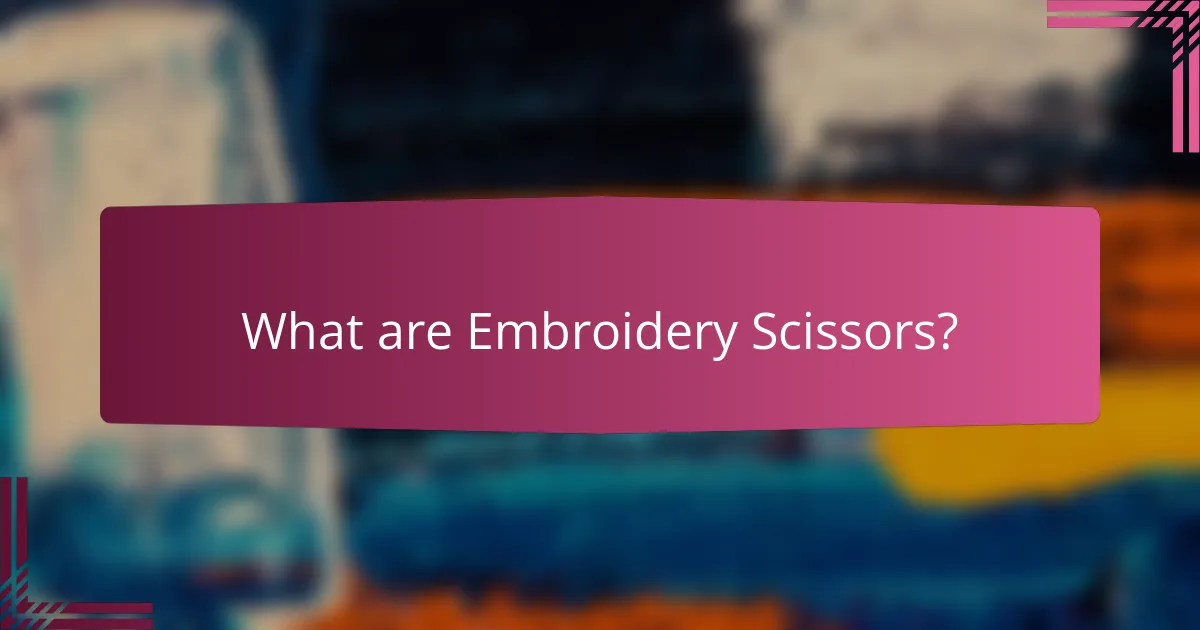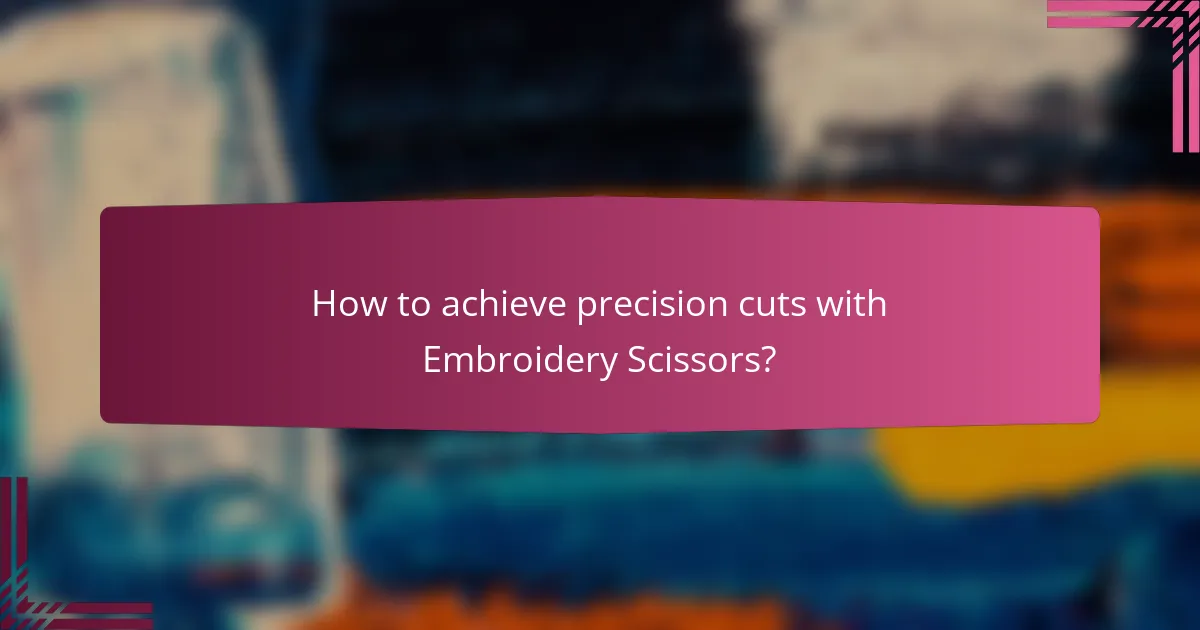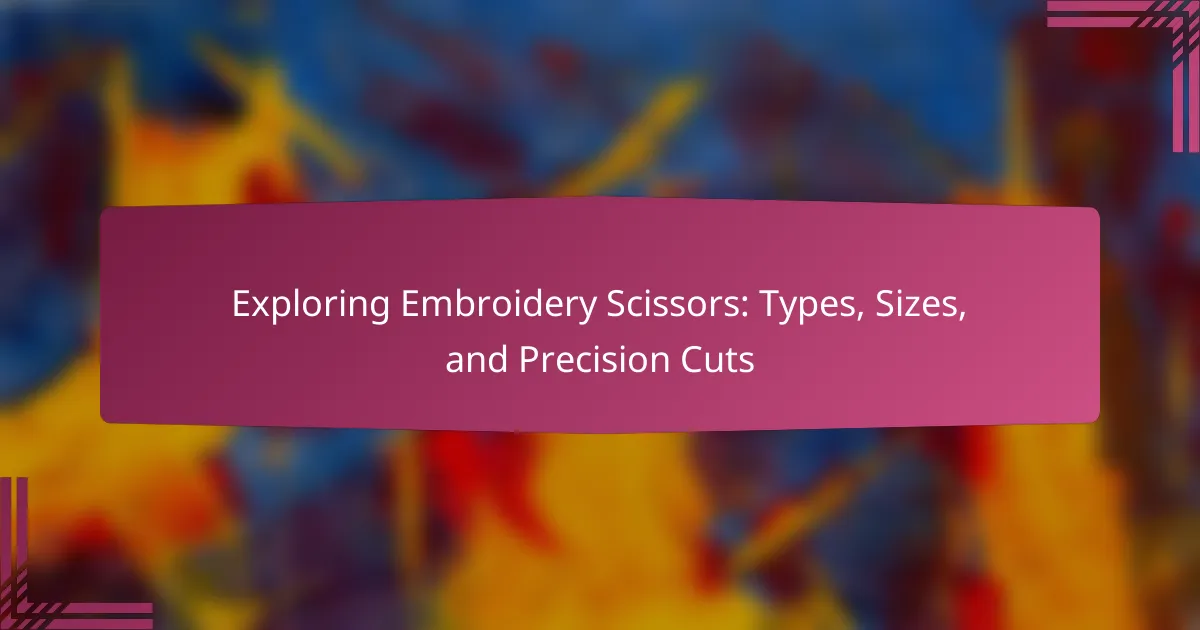
What are Embroidery Scissors?
Embroidery scissors are specialized cutting tools designed for precision cutting in embroidery work. They typically feature a sharp, pointed tip for detailed snipping of threads. The small size allows for maneuverability in tight spaces. Embroidery scissors often have ergonomic handles for comfort during extended use. They are usually made from stainless steel for durability and corrosion resistance. These scissors come in various designs, including decorative handles and unique shapes. Their primary function is to trim excess threads and achieve clean finishes in embroidery projects. Their precision is essential for maintaining the quality of intricate designs.
How do Embroidery Scissors differ from regular scissors?
Embroidery scissors differ from regular scissors primarily in their design and functionality. Embroidery scissors are specifically crafted for precision cutting of threads and fabric in detailed work. They typically feature a pointed tip for intricate snipping and small blades for accuracy. Regular scissors have a broader blade design, suited for general cutting tasks. The shorter length of embroidery scissors allows for better control in tight spaces. Additionally, embroidery scissors often come with a decorative handle, enhancing their aesthetic appeal. Regular scissors prioritize versatility over precision, making them less effective for detailed embroidery tasks.
What specific features make Embroidery Scissors unique?
Embroidery scissors are unique due to their specialized design for precision cutting. They typically feature a sharp, pointed tip that allows for intricate cuts in tight spaces. The blades are often shorter than regular scissors, enhancing control during detailed work. Many embroidery scissors are made from high-quality stainless steel, ensuring durability and longevity. Their ergonomic handles are designed for comfort during extended use. Some models include decorative elements, making them aesthetically pleasing. The unique size and shape facilitate precise trimming of threads without damaging the fabric. These specific features distinguish embroidery scissors from general-purpose scissors.
Why is precision important in embroidery cutting?
Precision is crucial in embroidery cutting to ensure clean, accurate edges. Accurate cuts prevent fraying and maintain the integrity of the fabric. Precision also allows for better alignment with embroidery patterns. This is essential for achieving the desired design and visual appeal. Furthermore, precise cutting reduces the risk of mistakes that could lead to wasted materials. Studies show that high-quality embroidery requires meticulous attention to detail. Therefore, precision in cutting directly impacts the overall quality of the finished product.
What are the common types of Embroidery Scissors?
Common types of embroidery scissors include pointed scissors, curved scissors, and snip scissors. Pointed scissors are ideal for detailed work and cutting intricate designs. Curved scissors allow for precise trimming around edges and contours. Snip scissors are designed for quick cuts and are often used for thread trimming. Each type serves a specific purpose in embroidery, enhancing accuracy and efficiency during the crafting process.
What are the characteristics of straight scissors?
Straight scissors are characterized by their two blades that meet at a pivot point. These blades are typically straight and sharp along their entire length. The handles are designed for comfort and control during cutting. Straight scissors are commonly used for a variety of cutting tasks. They provide a clean and precise cut on fabrics and paper. The blade length can vary, impacting the cutting efficiency. They are often made from stainless steel for durability. Straight scissors are essential tools in embroidery and crafting.
How do curved scissors enhance embroidery work?
Curved scissors enhance embroidery work by providing precision cutting along intricate designs. Their unique shape allows for better maneuverability around curves and corners. This design helps prevent accidental snips in surrounding fabric. Curved scissors also offer improved visibility of the cutting line. The ergonomic grip reduces hand fatigue during prolonged use. Additionally, they facilitate detailed trimming of threads and fabric edges. This results in cleaner finishes and more professional-looking embroidery. Overall, curved scissors are essential tools for achieving high-quality embroidery results.
What are the benefits of using snip scissors?
Snip scissors offer precision and control for detailed cutting tasks. They are specifically designed for intricate work, making them ideal for embroidery. Their small size allows for easy maneuverability in tight spaces. Snip scissors typically have sharp, pointed tips to achieve clean cuts. This design helps to reduce fraying of fabric edges. They are lightweight and easy to handle, reducing hand fatigue during prolonged use. Many snip scissors also feature ergonomic handles for added comfort. Overall, they enhance accuracy and efficiency in embroidery projects.

What sizes of Embroidery Scissors are available?
Embroidery scissors are available in various sizes, typically ranging from 3 inches to 6 inches in length. The most common sizes include 3.5 inches, 4 inches, 5 inches, and 6 inches. Smaller scissors, like the 3.5-inch option, are ideal for intricate work and detailed cutting. Medium sizes, such as 4 and 5 inches, offer a balance between precision and ease of handling. The 6-inch scissors provide a larger cutting surface, suitable for broader cuts. These size variations allow users to select scissors based on their specific embroidery needs and preferences.
How does the size of Embroidery Scissors impact usability?
The size of embroidery scissors significantly impacts usability. Smaller scissors provide precision for intricate cuts and tight spaces. They allow for detailed work on small fabric pieces. Larger scissors can cut through multiple layers but may lack the finesse needed for delicate tasks. Users may find it challenging to maneuver larger scissors in confined areas. The choice of size affects comfort and control during use. A study by the Craft and Hobby Association indicates that ergonomic designs enhance user experience. Ultimately, the right size improves efficiency and accuracy in embroidery projects.
What are the common sizes of Embroidery Scissors?
Common sizes of embroidery scissors typically range from 3 to 6 inches in length. The most common size is around 4 inches, which provides a balance of control and precision. Smaller scissors, like 3 inches, are ideal for intricate work and tight spaces. Larger scissors, around 5 to 6 inches, are suited for cutting multiple layers or larger pieces of fabric. These sizes are widely used by crafters and professionals alike. The choice of size often depends on the specific task and personal preference.
When should you choose larger scissors versus smaller ones?
Choose larger scissors for cutting thick materials or long straight lines. Larger scissors provide more leverage and can handle bulkier fabrics effectively. They are ideal for tasks such as cutting multiple layers of fabric or large patterns.
Select smaller scissors for precision tasks or intricate cuts. Smaller scissors allow for better control and maneuverability in tight spaces. They are perfect for detailed work like trimming threads or making small snips in delicate fabrics.
In summary, larger scissors suit heavy-duty cutting, while smaller scissors excel in detailed, precise work.
What factors should you consider when selecting the size?
When selecting the size of embroidery scissors, consider the intended use and precision required. Smaller scissors provide greater control for intricate designs. Larger scissors are suitable for cutting through multiple layers of fabric. The comfort of the handle is also essential for prolonged use. Blade length affects maneuverability; shorter blades excel in tight spaces. Weight influences ease of handling; lighter scissors reduce hand fatigue. Personal preference plays a role in size selection, as individuals may favor different dimensions. Ultimately, matching size to specific embroidery tasks ensures optimal results.
How does hand size influence scissor choice?
Hand size significantly influences scissor choice by determining the comfort and control during use. Larger hands may require scissors with longer handles for a better grip. Conversely, smaller hands benefit from shorter handles that allow for precise movements. The blade length also varies with hand size; longer blades suit larger hands, while shorter blades are ideal for smaller hands. Proper fit enhances cutting accuracy and reduces hand fatigue. Studies show that ergonomic design improves user experience. Selecting scissors that match hand size is crucial for effective embroidery tasks.
What role does the type of embroidery play in size selection?
The type of embroidery significantly influences size selection. Different embroidery techniques require varying amounts of fabric manipulation and design density. For instance, dense embroidery styles may necessitate larger fabric areas to accommodate the stitching. Conversely, simpler designs may allow for smaller sizes without compromising the integrity of the embroidery.
Additionally, the type of thread used can affect the finished size. Thicker threads may require more space, impacting the final dimensions of the embroidered piece. The choice of embroidery method, such as machine versus hand embroidery, also plays a role in determining the appropriate size.
In summary, the type of embroidery directly affects the size selection due to design complexity, thread thickness, and the method employed.

How to achieve precision cuts with Embroidery Scissors?
To achieve precision cuts with embroidery scissors, hold the scissors at a comfortable angle. Ensure the blades are sharp for clean cuts. Use the tips of the scissors for intricate details. Move the fabric slowly to maintain control. Keep your hand steady while cutting along the desired line. Practice on scrap fabric to improve your technique. Regular maintenance of the scissors enhances their cutting ability. Proper lighting helps in seeing the cutting line clearly.
What techniques can improve cutting precision?
Techniques that can improve cutting precision include using sharp blades and maintaining proper angles. Sharp blades reduce resistance, allowing for cleaner cuts. Proper angles ensure that the scissors align with the material for accurate slicing. Additionally, consistent pressure during cutting helps maintain control. Using cutting mats can provide a stable surface, enhancing stability. Regular maintenance of scissors, such as oiling the pivot, ensures smooth operation. Practicing cutting techniques can also improve skill over time. Research indicates that precision tools yield better results in crafts, reinforcing the importance of quality equipment.
How does proper grip affect cutting accuracy?
Proper grip significantly enhances cutting accuracy. A secure grip allows for better control of the scissors. This control helps in making precise cuts along intended lines. When the grip is firm, the user can apply consistent pressure. Consistent pressure reduces the likelihood of slipping. This leads to cleaner, more accurate cuts. Studies show that grip strength correlates with cutting performance. For example, a study published in the Journal of Hand Therapy found that improved grip strength can increase cutting precision in various tasks. Thus, a proper grip directly influences cutting accuracy in embroidery scissors.
What are the best practices for maintaining sharp blades?
To maintain sharp blades, regularly clean them after each use. This prevents residue buildup that can dull the edge. Use a soft cloth or brush to remove debris. Apply a drop of oil to the pivot point to ensure smooth operation. Store blades in a protective case or sheath to avoid accidental damage. Sharpen blades using a whetstone or honing tool as needed. Follow the manufacturer’s recommendations for sharpening frequency. Regular maintenance extends the lifespan of the blades and ensures optimal performance.
What common mistakes should be avoided when using Embroidery Scissors?
Common mistakes to avoid when using embroidery scissors include using them for tasks other than cutting thread or fabric. This can dull the blades and reduce effectiveness. Another mistake is cutting with the tips instead of the blades, which can lead to uneven cuts. Additionally, not keeping the scissors clean can result in residue buildup, affecting performance. Failing to store scissors properly can also lead to damage. Lastly, using excessive force while cutting can cause the blades to misalign or bend. Each of these practices can negatively impact the longevity and precision of the scissors.
How can improper cutting techniques damage fabric?
Improper cutting techniques can damage fabric by causing fraying and uneven edges. When fabric is cut incorrectly, the fibers can be pulled or stretched. This leads to a loss of structural integrity. Additionally, jagged cuts can create weak points in the material. These weak points may result in tears during handling or washing. Using dull scissors exacerbates this issue, as they crush rather than cut fibers cleanly. The choice of cutting angle also affects the outcome; incorrect angles can distort the fabric shape. Ultimately, these factors can compromise the overall quality of the finished product.
What should you avoid to maintain the longevity of your scissors?
Avoid cutting materials that are too thick or hard for your scissors. This can dull the blades quickly. Do not use scissors for tasks other than cutting fabric or paper. Misusing scissors can lead to damage. Avoid exposing scissors to moisture or humidity. This can cause rust and corrosion. Do not store scissors in damp environments. Proper storage is essential for longevity. Avoid using scissors on surfaces that can dull the blades, like metal or hard plastic. This ensures they remain sharp for precision cuts.
What tips can enhance your embroidery cutting experience?
Use sharp, high-quality embroidery scissors for precise cuts. Sharp scissors reduce fraying and allow for clean edges. Choose scissors with a comfortable grip to minimize hand fatigue during extended use. Employ proper cutting techniques, such as cutting away from the fabric to avoid accidental snags. Keep scissors clean and well-maintained to ensure optimal performance. Use a cutting mat to protect surfaces and enhance cutting accuracy. Practice cutting on scrap fabric to refine your technique before working on final projects. Proper lighting can also improve visibility and accuracy while cutting.
Embroidery scissors are specialized cutting tools designed for precision in embroidery work, featuring sharp, pointed tips and ergonomic handles for comfort. This article explores the various types of embroidery scissors, including pointed, curved, and snip scissors, and discusses their unique features, sizes ranging from 3 to 6 inches, and the importance of precision in cutting to maintain fabric integrity. Key factors such as hand size, type of embroidery, and best practices for maintaining sharp blades are also examined to enhance the user’s cutting experience and ensure optimal results in embroidery projects.
